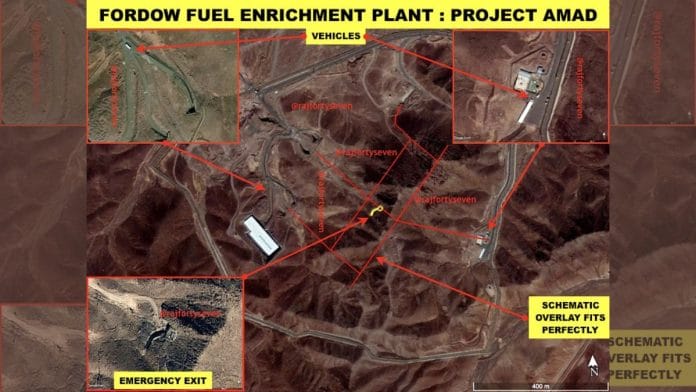New Delhi: As the conflict between Israel and Iran enters its seventh day, the world’s attention remains fixed on one of Iran’s most fortified nuclear sites, the Fordow Fuel Enrichment Plant.
Since launching ‘Operation Rising Lion’ last Friday, Israel has carried out a series of strikes aimed at degrading Iran’s nuclear and ballistic missile capabilities. Yet, so far, the underground Fordow facility remains untouched.
Located deep in the mountains near the city of Qom and nearly 161 km from Tehran, Fordow remains a core part of Iran’s nuclear infrastructure, enriching uranium up to 60 percent purity, far beyond what is required for civilian energy use, and edging closer to weapons-grade.
Furthermore, Iran could convert its current stockpile of 60 percent enriched uranium at Fordow into 233 kg of weapons-grade Uranium (WGU) in just about three weeks, according to Institute for Science and International Security.
“Around 233 kg of WGU would be enough to produce nine nuclear weapons, given that 25 kg of WGU is required to produce one nuclear weapon,” the US-based research and advocacy group’s assessment reads.
The plant is reportedly buried up to 300 ft into the side of a mountain, placing it well beyond the reach of Tel Aviv’s existing arsenal. Israeli aircraft and munitions, no matter how precise, lack the penetrative power to destroy such a deeply fortified site.
In such a situation, the focus is now on the GBU-57A/B Massive Ordnance Penetrator (MOP), more commonly referred to as the bunker buster bomb, a specialised weapon engineered for precision targets hidden deep underground.
More importantly, the US only has this weapon in its arsenal while Israel does not have any aircraft in its inventory to deliver and launch the MOP. The American B-2 Spirit stealth bomber is said to be the only aircraft to carry out such a challenging mission
As of now, the US Air Force has less than 20 B-2s. Capable of flying over 11,000 km without refueling, with aerial refueling extending its range globally, the bomber’s stealth design, internal weapon bays and high-altitude cruise capabilities make it ideal for evading sophisticated air defence systems while delivering high-precision strikes.
In Iran’s context, the B-2 gives the US the ability to strike the hardened nuclear sites like Fordow, the kind of targets no conventional aircraft or missile can effectively neutralise.
Also Read: Trump’s warning for Iran after Israel’s Op Rising Lion—make a deal to avoid further ‘slaughter’
What is GBU-57 A/B?
Developed by Boeing, the GBU-57 A/B is the world’s largest non-nuclear bomb. It weighs 30,000 pounds or 14,000 kg and measures 20 ft in length, packed into a hardened steel casing specifically designed to pierce through reinforced concrete and dense rock.
The ‘GBU’ stands for Guided Bomb Unit, and the 57th design in the series. The ‘A/B’ in its name refers to its version or block, with alphabetic suffixes used by the U.S. military to denote design updates and modifications.
Shaped like a narrow cylinder around 2.5 ft in diameter, the bomb is capable of penetrating up to 200 ft (roughly 61 m) of rock or concrete with a compressive strength of 5,000 psi, the kind used in bridge decks or heavily reinforced bunkers. After it tunnels through, its 5,300-pound (about 2,400 kg) high-explosive charge detonates, causing catastrophic internal shockwaves designed to destroy underground infrastructure.
The GBU-57 A/B has not yet been used in combat, although earlier and lighter variants have been used by America. The US Air Force is reported to have a total of 20 GBU-57s which were delivered by Boeing in September 2011.
It is also widely believed that a single strike is unlikely to be enough against a site like Fordow. That’s where the bomb’s GPS guidance system and delayed fuse come in. The munition can strike the same target multiple times with high precision, allowing follow-up bombs to burrow even deeper than the first impact.
Because of the bomb’s size, no Israeli fighter aircraft, including the F-15s and F-35s, are capable of carrying it. That role would fall exclusively to the B-2s. After being released from a high altitude, likely from 50,000 ft, the bomb’s precision fins and onboard guidance system take over.
While the exact impact velocity is classified, estimates suggest that the bunker buster travels at over Mach 1, i.e., more than 1,200 km/hr. At that speed, the bomb would generate a kinetic energy of 800 to 900 megajoules. For comparison, that’s equivalent to the force of a 285-ton Boeing 747 landing at 274 km/h, concentrated into a single, narrow impact zone.
(Edited by Tony Rai)






